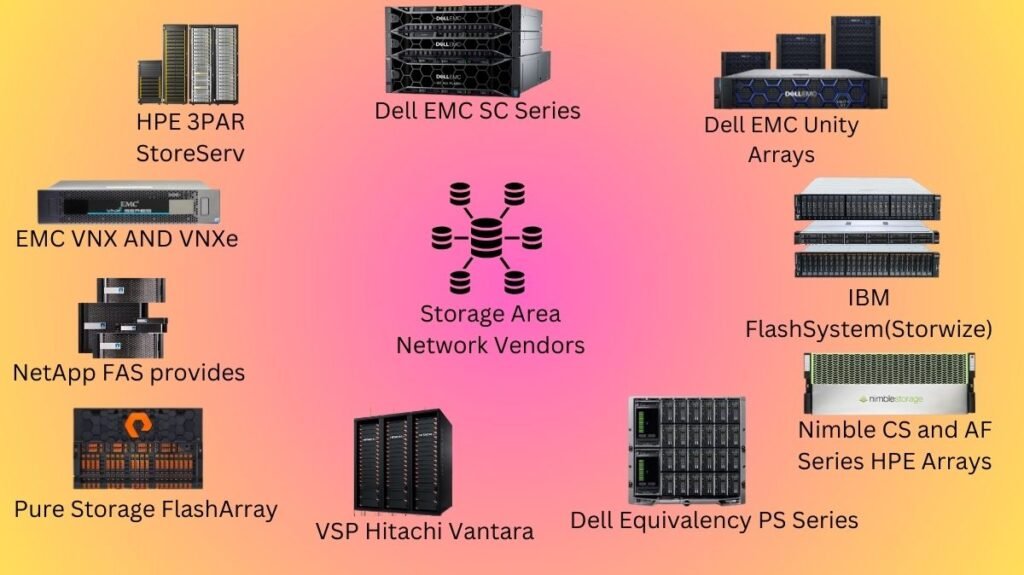Storage Area Network Vendors

Because SANs are costly, finding the best data storage option for your organisation requires careful planning and comparison shopping. Cost, scalability, performance, reliability, availability, administration, simplicity of use, and data security are some of the factors IT decision-makers must consider.
The following high-quality Storage Area Network(SAN) products, which storage array providers usually carry, may help you focus your search:
HPE 3PAR StoreServ
The flash-optimized HPE 3PAR StoreServ family of servers provides quick and automated provisioning. 3Par StoreServ offers 75% capacity savings and 8 times quicker provisioning than non-flash competitors by utilising a multi-tenant architecture.
The HPE 3PAR StoreServ 7000 Storage is a reference to the whole 7000 series, which comprises the 7000c models (7200c, 7400c, 7440c, and 7450c) as well as the 7000 models (7200, 7400, and 7450). The HPE 3PAR StoreServ 8000 Storage replaced the 7000 series and was released in August 2015.
EMC VNX AND VNXe
A variety of connectivity options are available for both block access and file access as a NAS system with the Dell EMC VNX range of storage devices. The VNX family has two distinct series: the VNXe, aimed at entry-level storage systems, and the VNX, a mid-tier system.
There is still value in these amazing systems even after Dell EMC dropped the VNX series in favor of its Unity offerings.
NetApp FAS provides
For dispersed corporations and midsized organizations, NetApp FAS provides robust, reasonably priced, and adaptable data storage. File-based and block-based protocols are used by the NetApp filer (also called NetApp Fabric Attached Storage) series to expose storage across the network in an enterprise level Storage Area Network (SAN) environment. The FAS Series is a more powerful storage platform than other systems in its class and is reasonably priced. The Info-Tech Research Group dubbed it the “Best in Overall Value.”
Pure Storage FlashArray
The first enterprise-class, all-NVMe flash storage array in the world is called Pure Storage FlashArray. It is a new type of storage called shared accelerated storage, which offers significant improvements in terms of simplicity, performance, and consolidation. For the next ten years, Pure Storage will remain innovative and cutting edge. Pure eliminates the hassle of storage ownership and provides unmatched customer satisfaction without the need for forklift upgrades or scheduled downtime.
VSP Hitachi Vantara
The VSP platform supports workloads ranging from DevOps to AI applications to mainframe systems and offers a number of product lines aimed at midrange to enterprise clients. also VSP systems come with built-in data protection features including at-rest encryption and replication, and they also provide 100% availability. The G Series hybrid, the F & E Series all-flash versions, and, lastly, their most current 5000 Series are all part of the family.
The Dell Equivalency PS Series
While maintaining the ease of EqualLogic management, EqualLogic PS Series arrays offer a new level of performance to support more of your most demanding applications and virtualization needs. It is perfect for businesses with expanding data and performance requirements since it comes with six array configurations, including 2U/2.5 drive variants with All Flash and Hybrid Arrays. It is frequently likened to HP Storage Works.
Nimble CS and AF Series HPE Arrays
The fastest and most dependable data access is provided by the Nimble CS and AF Series adaptive flash storage, which bridges the app-data gap. Customers may drastically streamline processes by integrating flash storage with predictive analytics.
IBM FlashSystem(Storwize)
Flash memory chips are used to store data in IBM FlashSystem corporate computer data storage systems. FlashSystem devices employ unique hardware based on technology from IBM’s 2012 acquisition of Texas Memory Systems, in contrast to storage systems that use ordinary SSDs. Compared to competing products, Storwize hardware offers advantages in performance, dependability, and efficiency.
Dell EMC Unity Arrays
One of Dell EMC’s mid-range storage array product lines is called Dell EMC Unity. It was created from the ground up as the EMC VNX and VNXe series’ successor in the midrange unified storage array market. Unity arrays provide the utmost in value and simplicity, allowing your company to tier storage to the cloud with ease, expedite implementation, and simplify maintenance.
Dell EMC SC Series
A single platform for the highest level of performance, versatility, and machine-driven efficiency is offered by Dell EMC SC Series arrays. SC Series storage’s open, future-ready design allows for easy integration with infrastructure and applications, allowing you to expand on a single platform and add features without upgrading your equipment.
Components Of A SAN
Servers, storage, and network infrastructure are the three main parts of SAN. These parts are separated into essential components such cabling, storage arrays, node ports, connecting devices, and SAN administration software.
Node ports
In a fibre channel, nodes are units that serve as a source or destination for several nodes. These consist of, among other things, tape libraries, servers, and memory. At least one or more ports on each node enable communication with other nodes. Ports use both a transmit (Tx) channel and a receive (Rx) link to send data in full duplex mode.
The cabling
Data is transferred by optical fibre cabling in SAN architecture. Optical cables come in two forms.
Multi-mode fibre (MMF)
Light beams aimed at various angles are concurrently transmitted onto the fibre cable’s core via the MMF cable. Light beams passing via these wires frequently scatter and collide after a certain distance, reducing signal strength and modal dispersion. The MMF cables may thus be used for shorter distances up to 500 meters.
Cable made of single-mode fibre (SMF)
A single laser beam is sent through the fiber’s core via the SMF cable. The cable’s tiny core lessens modal dispersion. As a result, data may be sent over larger distances up to 10 kilometers using SMF cables.
Interconnected devices
Ports, network switches, and directors are the equipment that are most often connected in SANs. Hubs are used as communication equipment in fibre applications to physically connect several nodes in a star or rational loop configuration. Since switches send data directly from one terminal to another, they are more intelligent than hubs. Directors are used to build data centre networks and are more noticeable than switches. Compared to switches, they feature more ports and a better failure tolerance.
SAN management software
The interface between the host, storage arrays, and connecting devices is controlled by the SAN administration software. Connecting storage systems, switches, and zoning the logical division of the SAN are among the crucial administrative functions that are included in the SAN administration software. Important SAN components like storage and connectivity devices are also managed by it.
Storage array
A system for storing block, object, or file-based data is called a storage array. The main objective of a SAN is to provide storage resources to the host. Implementations of SAN storage provide the host with multiple-host connection, business continuity, high availability and redundancy, and enhanced performance.

